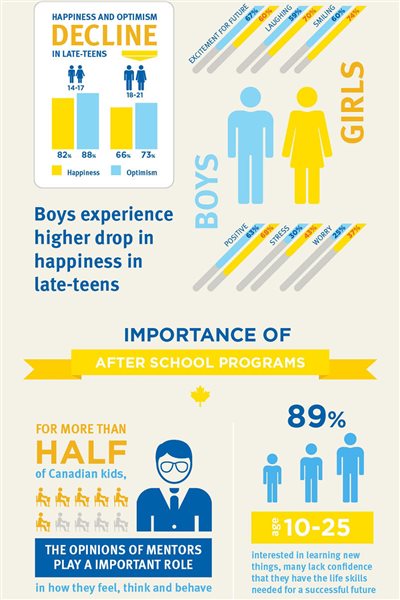
Many will have heard of the phenomenon of the so-called “mid-life crisis” when people aged somewhere between roughly 35-50 years old question their lives, goals, future and so on.
A new survey of Canadian youth shows what appears to be a phenomenon of a “quarter-life crisis”.
Called the “RBC Kids Optimism Survey”, this first survey of its kind polled some 2,387 Canadian youths between the ages of 10 to 25.
It showed that the optimism of youth wanes significantly as the realities of life are experienced in early adulthood.
Dr. Anthony Levitt is chief of the Hurvitz Brain Sciences Centre at Sunnybrook Health Sciences Centre in Toronto Ontario. He says,
“When young people leave the safety net of high school, they transition to a less-structured and sometimes isolating world of university, college or job-hunting.This stressful period is also often a time when youth turn to drugs and alcohol, which can exacerbate their pessimistic outlook on the world. We also know that this is the age at which youth can show the early signs of mental illness, which will affect their perception of the possibilities available to them and their sense of overall happiness.”
Topline Findings Among Those Aged 10 to 25
Attitudes toward life, future, family change in late-teens
- -As teens age, they’re less likely to say they have a good life, that their family believes in them and makes them feel good.
- Girls are happier than boys, but boys are more excited about the future
- -When it comes to level of excitement about the future, boys (67 per cent) are more excited than girls (60 per cent).
- -While most Canadian kids would describe themselves as happy, a dramatic decline occurs in the late-teen years.
- -Most boys aged 14 to 17 report being happy (81 per cent), which drops 18 points to just 63 per cent among those aged 18 to 21 compared to 69 per cent of girls in the same age range.
- Satisfaction with life and tendency towards optimism drop among late teens
- -While 95 per cent of teens aged 14 to 17 say they’re satisfied with their life, satisfaction dips sharply to 82 per cent among those aged 18 to 21, and 79 per cent among those aged 22 to 25.
- Positive feelings are lowest, negativity highest, among those aged 18 to 21
- -Frequent feelings of happiness and laughter decrease 20 per cent among those aged 18 to 21; smiling drops 19 per cent, while stress and worry both jump more than 30 per cent.
- Girls smile more, but also worry more, than boys
- -Top worries among both genders include money (68 per cent), things happening in the world (66 per cent), getting or having a job (63 per cent), knowing what career to pursue (57 per cent) and their parents (50 per cent).
An additional finding of the survey shows that while majority of Canadians aged 10-25 say that they are interested in learning new things (89 per cent), many lack confidence that they have the life skills needed for a successful future.







For reasons beyond our control, and for an undetermined period of time, our comment section is now closed. However, our social networks remain open to your contributions.